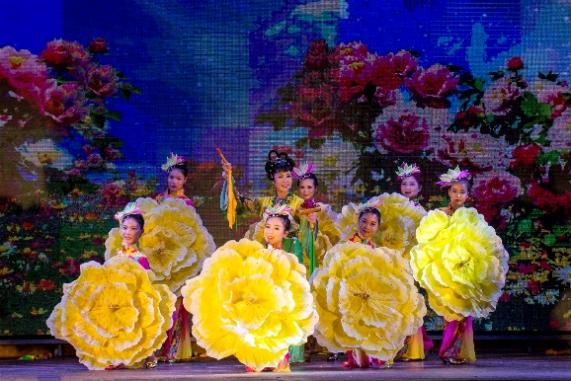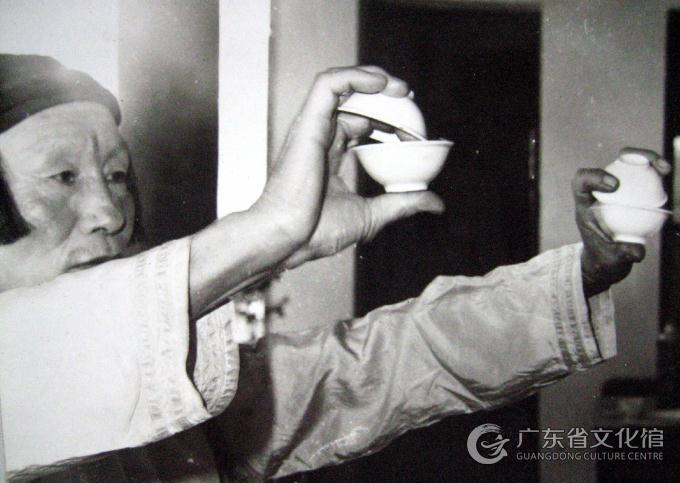客家方言区
客家是唯一一个不以地域命名的民系,客家先民自东晋南北朝起,不断迁徙,于三江平原(三江指赣江、汀江、梅江)等地发展成客家民系。目前,客家人主要集中分布在广东、广西、江西、浙江、福建等地。(Hakka people, a branch of Han nationality, have a long history of southern migration dating back to East Jin Dynasty and Southern and Northern Dynasties in ancient China. The earliest Hakka ancestors settled on the plain formed by the alluvial of three rivers, namely, Ganjiang River, Tingjiang River and Meijiang River. At present, the Hakka people mainly live in several southern provinces in China such as Guangdong, Guangxi, Jiangxi, Zhejiang and Fujian.)
客家方言是古汉语的活化石,保留了大量古汉语音韵和发音特征。(The Hakka dialect is known as a living fossil of ancient Chinese, retaining many of its phonology and pronunciation features.) 如第一人称口语“我”(读作“亻厓”)就包含了古汉语的发音特点。客家歌舞艺术以客家方言为载体,悠扬曲调和翩跹舞步中体现出鲜明的客家文化色彩。(Hakka singing and dancing art based on Hakka dialect embody the characteristics of Hakka culture in its melodious tune and graceful steps.) 本期“记忆的味道”将带领大家走进客家木鱼曲和杯花舞,感受客家文化。
客家方言区分布图
摘自《中国语言地图集第2版汉语方言卷》
上外英院传统文化志愿服务队的小伙伴们来到北海合浦,采访了公馆木鱼第四代传承人廖烈莲老师,倾听她眼中的公馆木鱼:
1
公馆木鱼
Gongguan Wooden Fish
广西北海市合浦县公馆镇,是北海客家人第一大镇。在这里一种独特的曲艺已流传200余年,那就是“合浦公馆木鱼”。(Gongguan Town located in Hepu County, Beihai City, Guangxi, is the largest Hakka town in Beihai. Hepu Gongguan Wooden Fish, a unique folk art has been around there for over 200 years.)
明嘉靖年间,合浦县廉州府张五老爷强抢一位名为金牡丹的女子,廉湖书院书生发动民众抗议,金牡丹因此重获自由。在庆贺宴上,常敲木鱼行乞卖唱的民间艺人编了独特的“牡丹花”曲调。从此曲调伴随民间故事,广为流传。(During the Jiading period of the Ming Dynasty, Master Zhangwu of Lianzhou Prefecture, Hepu County took over forcibly a girl named Golden Peony, who regained her freedom later thanks to the public protest agitated by some young intellectuals of Lianzhou Academy. At the celebratory party, some street performers, who begged for living by singing to the tapping of wooden fish, improvised the tune entitled “Peony Flower”. Since then, the unique tune, along with the folk tales, has been widely spread.)因此,“公馆木鱼”又名“金牡丹”。(Hence, the “Gongguan Wooden Fish” is also called “Golden Peony”.)
曲调特征与演绎形式
“那个呢呀金牡丹女哪,牡丹花,一对鸳鸯对凤凰哪。”——“牡丹花”曲调高亢明快,如今已不限于这单一曲式:木鱼调、客家山歌、快板、道白都穿插运用其中。歌词、快板以七言为主,双句押韵,后拖尾腔。( “Peony Flower”melody features a high and lively tune. Up till now, such musical forms as wooden fish tune, Hakka folk song, allegro and speaking are incorporated into the performance of the “Peony Flower” melody. Lyrics and allegro mainly come in seven characters and rhyme in every other line ending in a drawl.)
通常演唱者一人分饰多角,一手木鱼,一手敲打。(Normally, one singer plays multiple roles, with one hand holding a wooden fish and the other tapping it.) 如今,舞台上多以众人共同演绎的形式出现,伴奏乐器改用更方便的竹板,增加了二胡、三弦等,音乐效果更为丰富。(Nowadays, the performance is usually given by many people on the stage. Such accompaniment musical instruments as bamboo clappers, erhu and sanxian are used in the performance to make the music sound richer.)

发展和现状
百年前,民间艺人手敲木鱼,贺廉湖书生,传播正道;百年后,客家非遗传人建传习基地,携青年群体,重振“公馆木鱼”热潮。2012年,公馆木鱼被列入广西非物质文化遗产名录(Gongguang Wooden Fish was entered in Guangxi Intangible Cultural Heritage List in 2012),以廖烈莲老师为代表的客家非遗传承人,组建“金牡丹”公馆木鱼艺术团,创作出《月光光,照地方》(Moonlight, Shines on the Ground),《复兴巨轮党领航》(The Great Ship of Revival Navigated by the Party)等新曲目,将文艺演出与理论宣讲相结合,致力于复兴“公馆木鱼”文化,并将其送往世界舞台,助力民间艺术走向更加广阔的天地。

文化价值
公馆木鱼因人间真情在合浦县落地生根,发芽开花。其中的一词一曲,都深深扎根于客家文化的土壤,是客家人的文化瑰宝,更是远方游子的精神寄托。(Deeply rooted in Hakka culture, every word and note of Gongguan Wooden Fish was the treasure of Hakka culture and spiritual ballast for Hakkas who live far from their hometown.) 如今,公馆木鱼成为客家地区文化传播的重要载体,为海内外的客家人架起一道心灵的桥梁,集实用价值、艺术价值及社会价值于一身,是传承和发扬客家文化艺术不可多得的民间艺术精品。(Now, Gongguan Wooden Fish has become an important carrier of Hakka cultural transmission, serving as a bridge linking all the Hakka people home and abroad. Because of its practical value, artistic value and social value, Gongguan Wooden Fish is undoubtedly one of the folk art treasures that inherits and carries forward Hakka culture.)
2
杯花舞
Beihua Dancing
“客家妹子客情长,情甜甜过冬蜜糖。杯花声声迎客来,欢天喜地乐洋洋。” (Full of affection, Hakka girls dance,/ Sweeter than honey in cold winter./ Clanking cups welcoming all the guests,/ Everyone is filled with great pleasure.) 伴随着婉转的歌声与悦耳的杯声,客家姑娘们手执白色瓷杯,脚尖舞步轻点,演绎着兴宁传统舞蹈——杯花舞。(Accompanied by sweet songs and clink of teacups, Hakka girls performed Beihua dancing, a traditional dance in Xingning, holding and clinking teacups in their hands while dancing gracefully on their tiptoes.)
杯花舞起源于道教法事舞蹈,距今已有100多年历史。杯花舞以“伯公杯”为道具,客家山歌曲调为舞曲基调。(Beihua dancing originated as a religious performaed on Taoist rites, has a history of over 100 years. Bogong cup is used as a prop in Beihua dance accompanied mainly by some Hakka folk songs. With Bogong cups as props, Beihua dancing employs Hakka folk songs as the theme of its dance music.)这是一种以客家民间舞蹈动作为基础,综合了民族乐器演奏和打击乐合奏的舞蹈艺术。(Beihua dancing is an art based on Hakka folk dance, which also incorporates folk musical instrument performance and percussion ensemble.)

艺术特色
杯花舞艺术特色体现在三个方面。(Beihua dancing has three major artistic features.) 首先是舞蹈道具。(Firstly, dancing props are used in the performance.) 杯花舞所用的瓷杯为白色的“伯公杯”,杯口直径二寸,杯底直径九分,高二寸。舞者敲击舞杯,发出清脆声响,既丰富了舞蹈动作,也使舞蹈节奏更多变。其次是舞蹈技巧。(Secondly, a variety of dancing steps are used in the performance.)在杯花舞中,舞者通常边舞边唱、声情并茂。主要舞步有云步、横步、跪步、下板腰等步法。(The main dance steps include the cloud-like step, side step, kneeling step, backward bending step, etc.)通过基本舞步的自由组合,舞蹈寓于变化,进退自如。最后是音乐特色。(Lastly, the dance music is highly distinctive.) 杯花舞音乐在保留原有山歌曲调和民间小调的基础上,增加新的音乐元素,与“伯公杯”的敲击声相互融合,形成独特的伴奏音乐。

传承与发展
历史悠久的杯花舞,现已成为民间节庆娱乐时常见的表演项目。时光流转,杯花舞不断与时代特色结合,创新发展。(Beihua dancing, with a long history behind it, is now a repertoire in the folk festivial entertainment. It keeps pace with the times and embraces new development.)1983年,兴宁文化馆对杯花舞进行了改革,创作出《明月照山乡》并将其推上世界舞台,广受好评。
如今,兴宁拥有 24 支表演队,大批杯花舞艺人免费在全市推广和排练杯花舞。“非遗进校园”活动也如火如荼展开。传承路上,杯花舞不断创新发展,生动演绎客家文化。
牡丹花开绕客思,杯花声声传客情。(Around the blooming Golden Peony lingers Hakkas’ passion; Through the clanking Dazzling Cup passes Hakkas’ friendship.) 客家的音乐舞蹈非遗中蕴藏着客家人的勤劳朴实,也传递着对美好生活、崭新时代的祝愿。非遗传承的路上,客家文化随着悠扬的木鱼调,曼妙的杯花舞姿发扬踔厉,生生不息!(Along with the melodious tune of Gongguan Wooden Fish and the graceful steps of Dazzling Cup Dance, Hakka culture continuously advances in great vibe and vigor.)
参考资料:
[1] 北海市非物质文化遗产保护中心. 合浦公馆木鱼[OL].http://bhich.cn/nd.jsp?id=100
[2] 公馆木鱼-广西非物质文化遗产(合浦县) [OL]. http://culture.usatour.com.cn/culture/45/gongguanmuyu.html
[3] 合浦县人民政府门户网站.公馆木鱼:珠乡客家传世曲艺[OL](2019-03-01)http://www.hepu.gov.cn/ywdt_95978/hpyw/201903/t20190301_1865415.html
[4]合浦旅游. 厉害了!CCTV4发现之旅栏目播放《公馆木鱼·金牡丹》[OL](2017-10-16)https://mp.weixin.qq.com/s?__biz=MzI4NDE0ODMwNA==&mid=2650512358&idx=3&sn=042996f7f840a747250733cb238fee9e&chksm=f3f0ecd9c48765cff67bd52d1c24e641f6175b8c75d97792175392b10e71dcc99abad51d664f&scene=27
[5]中国新闻网,岭南写真:历久弥新的百年“杯花舞”[OL](2011-08-28)[2023-01-21]. https://www.chinanews.com.cn/qxcz/2011/08-28/3288443.shtml
[6]刘佳明.浅谈广东兴宁“杯花舞”的艺术特色[J].黄河之声,2016(11):114-115.
[7]刘利娜.兴宁杯花舞的传承与发展[J].神州民俗(学术版),2011,(03):87-89.
译文参考资料:
[1] The official Website of Zhongshan China: Tour of Lingnan intangible culture heritage firstly performed in Zhongshan
http://www.zs.gov.cn/ywb/features/culturalrelics/content/post_1650386.html
[2] China Central Television: CCTV 2022 Mid-Autumn Festival Gala
http://tv.cctv.com/2013/09/19/VIDE1379601125300588.shtml
[3] China Daily: Experts to those copying dance: Watch your back
https://global.chinadaily.com.cn/a/202202/08/WS6201be53a310cdd39bc85329.html
部分资料、图片来源于网络
我要评论 (网友评论仅供其表达个人看法,并不表明本站同意其观点或证实其描述)
全部评论 ( 条)